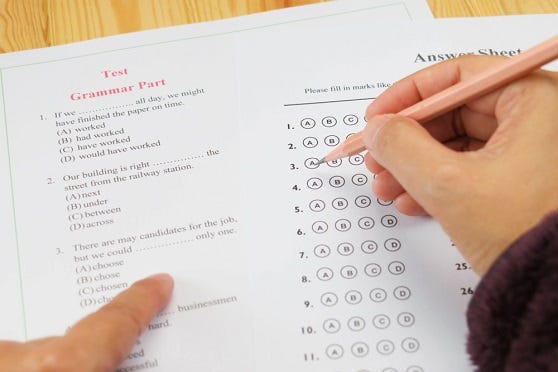TOEFL Test: 5 Tips to Get It Right

Are you feeling stressed about the TOEFL test?
This 5-step study guide can be the best way to achieve your target score and unlock exciting academic opportunities!
Step 1: Know your skill level
An understanding of your TOEFL skill level is important to know your strengths and weaknesses to help you focus on the studying process and make a good preparation strategy. For this, you could take a diagnostic test of TOEFL to find out where you stand and what your weakness areas are.
E2 Test Prep’s free TOEFL score calculator provides you with an idea of where you stand before starting a TOEFL prep course.
Step 2: Understand the structure of the TOEFL test
Get a head start on your TOEFL prep! You will learn about the test format by exploring official practice tests and resources from trusted websites.
The TOEFL iBT test has four sections of about 2 hours, but plan for 2.5 hours to include a 30-minute check-in time. Each section is briefly explained below:
- Reading (35 minutes): You will read two passages and answer questions about what you read.
- Listening (36 minutes): You will listen to lectures and conversations, then answer questions about what you heard.
- Speaking (16 minutes): You will get to talk about familiar topics and discuss things you have read or heard.
- Writing (29 minutes): You will write about what you read and heard, and also explain your own opinion on a topic based on Academic discussion.
Step 3: Practice makes progress
The best practice tests for TOEFL will introduce you to different question types as well as improve your skills and preparedness for the actual test.
Getting ready for the TOEFL iBT test on your schedule is easier than ever with official resources designed by ETS (Educational Testing Service) to fit your needs.
- TOEFL TestReady: This personalized online portal offers practice tests, courses, and guides to track your progress.
- Sample Test: Experience a 40-minute sample test that includes questions from all sections, giving you a feel for the actual TOEFL iBT.
- Tutors: Connect with tutors trained in teaching academic English, the kind you will face on the TOEFL iBT.
- Free Test Prep Planner: Download an 8-week plan packed with tips, activities, and sample questions to guide your TOEFL iBT preparation.
Step 4: Master the TOEFL with these Powerful Strategies
Here are some techniques that can give you better improvements.
- Note-Taking: Sharpen your listening and information memory by practicing note-taking from various English audio sources.
- Practice Makes Perfect: Regularly take practice tests to identify strengths, and weaknesses, familiarize yourself with the test format, and build test-day confidence. Use resources like the free EF SET test.
- Read Like a Champ: Expand your vocabulary and understanding by reading different topics in English such as science, social science. This builds a strong foundation for knowing various topics the TOEFL test subjects you.
- Level Up Your Listening: Listen to English podcasts! They improve your listening skills and provide opportunities to learn natural pronunciation by mimicking speakers.
- Type faster, write more: Learning to touch typing (typing without looking at the keyboard) will give you a big advantage in the TOEFL writing section. This helps you to spend less time looking for keys and more time focusing on your ideas. Many free websites and apps can teach you touch typing in a fun way.
Here are some quick basics:
- Home Row: Place your fingers on the middle row of keys (ASDF JKL;). This is your “home base” for typing.
- Finger Placement: Each finger has designated keys to press. Index fingers rest on the F and J keys, middle fingers on D and K, and so on.
- Practice Drills: Start with simple exercises focusing on specific rows or letters. Slowly increase your speed as your finger memory improves.
Step 5: Section wise tips
Note down some winning strategies for the TOEFL test’s four sections (Reading, Listening, Speaking, and Writing) to maximize your score!
✍ Reading
For the reading section, grab newspapers, magazines, or interesting books, anything with good writing. Read them aloud to improve both vocabulary and pronunciation. Take a grammar masterclass to work on your grammar skills and focus on tenses and parts of speech. Practice reading passages and answering questions based on them. The more you practice, the better you will become at understanding the main ideas and details.
✍ Listening
Listen to radio and TV broadcasts in English-language, because broadcasters typically speak clearly and correctly. Train yourself to take clear notes while listening to broadcasts or movies to become a better listener.
While the test uses American English, be prepared for various accents, and practice listening and understanding different speaking styles since a variety of accents could be used by the ETS to give a good exposition to familiarize the range of English speakers you might come across during your study in a college or university abroad.
✍ Speaking
Speak Up! Read textbooks or other materials aloud, focusing on clear pronunciation by reading along with audio content and mimicking the speaker. Record your speech to track your progress and compare your speaking to clear, professional voices. The more you know about your speaking topic, the more confident and convincing you will sound.
✍ Writing
Read a variety of materials for your research when creating opinions for the writing section to strengthen your arguments, and know what information to include in your writing. One strategy is to summarize as briefly as possible a paragraph that you read. This can enhance your paraphrasing skill as well.
By following these tips and practicing consistently, you will improve on each section of the TOEFL and get the best scores.



